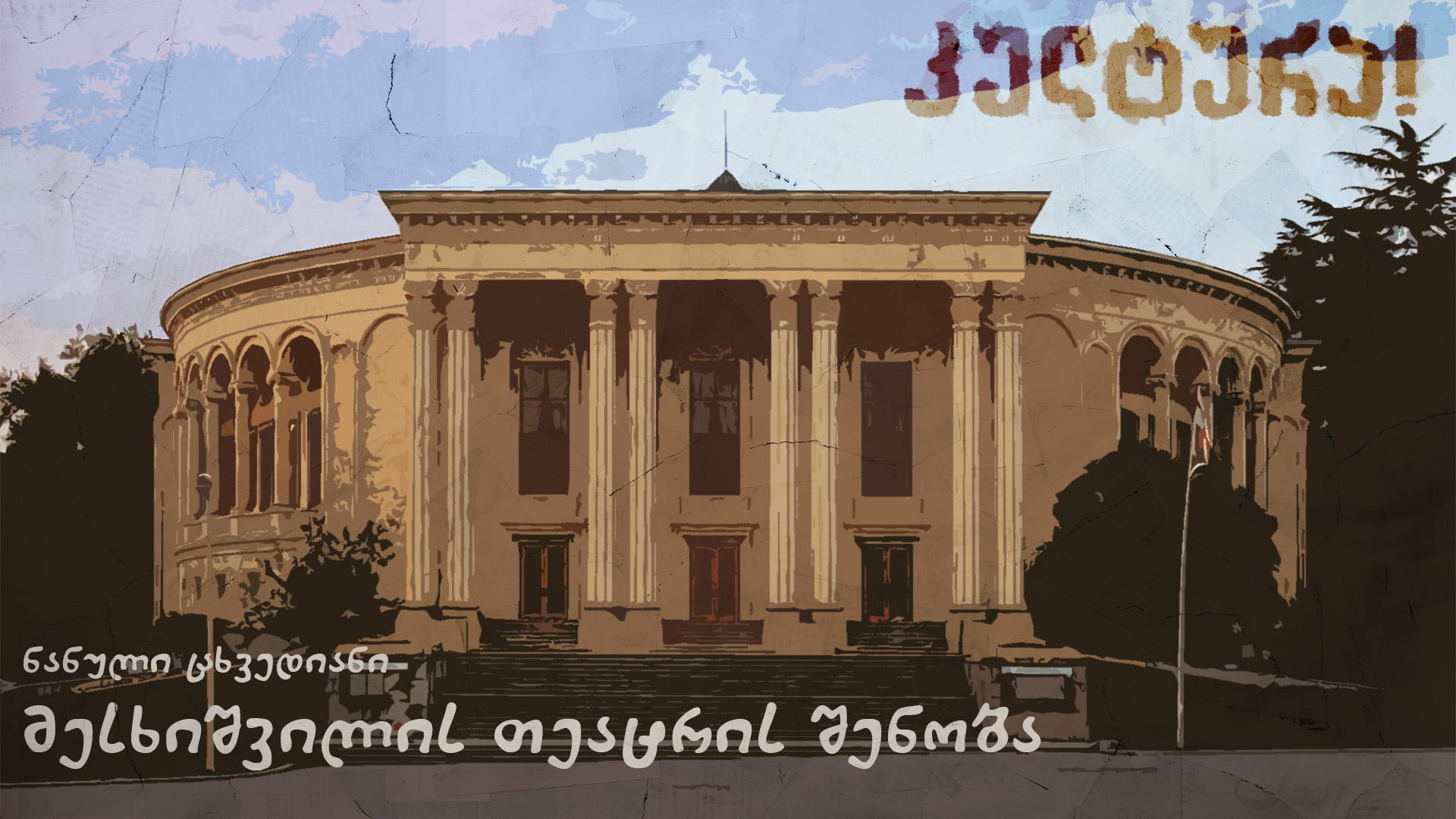Author: Nanuli Tskhvediani
Anyone who arrives at the central square of Kutaisi or walks by the State Theater named after Lado Meskhishvili, whether a foreign tourist, a local resident, or a visitor from other parts of the country, is inevitably enchanted by the grandeur of the building. Its exquisite forms, intricately carved capitals, and its harmonious integration with the space of the square captivate all who see it. Indeed, the theater building remains the most outstanding and monolithic structure in Kutaisi’s architecture – a magnificent creation by the renowned architect, honored artist, and corresponding member of the Academy of Architecture of the USSR, Mikhail Shavishvili (1894-1958).The planning and construction of the theater began shortly after the end of the Second World War and spanned several years. It was a significant communal effort, with widespread participation in its construction. During the 1940s and 1950s, Kutaisi’s press outlets, such as “Industrial Kutaisi,” “Stalinelli,” and “Kutaisskaya Pravda,” regularly published updates on the construction, highlighting the contributions of various enterprises and institutions. These organizations often organized “ shabatoba,” voluntary work days that were common in the Soviet era, to assist the builders.No concrete conditions were set for the architect regarding the location and surroundings of the theater. The architectural organization of the city’s central area was not predefined, leading to discussions about the potential layout of the square. These discussions included the continuation of the boulevard, the longitudinal axis of the new theater aligned with a monument, and a large administrative building on the square’s eastern side.The unique and expansive square, connected to a green garden area, demanded a theater building of corresponding height and volume. Shavishvili achieved this by designing wide entrances that seamlessly connected the new structure to the square. Furthermore, he increased the building’s overall height and presence by incorporating an artificially elevated lower floor.
Initially, the architect faced a critical decision regarding the building’s design: whether to opt for an excessively monumental style, typical of caste theaters in monarchical states, or to choose an overly decorative approach, reflecting pseudo-democratic forms and content with abundant decor. Mikhail Shavishvili, however, chose a different path. By moderately using national forms and ornamental motifs, he created the Kutaisi Theater building with an aura of attractiveness and democracy while maintaining its overall volumetric monumentality.Local, durable materials were employed for the facades’ architectural decoration. The walls and columns were constructed with white Eklar stone, while porphyry was used for the base. All decorative embellishments were crafted from Eklar stone.The internal architectural design of the building is equally impressive. The auditorium is shaped like a simple horseshoe, ensuring equally good visibility and acoustics on both the parterre and the tiers.Per the architect’s vision, the foyer was designed on a single level, creating a cohesive space. Its arc-like contour unfurls before the viewer in various aspects, enhancing the diversity and the impression of the interior space’s size.The theater’s backstage area is conveniently connected to the main lobby and other auxiliary spaces yet architecturally distinct from them.According to Mikhail Shavishvili’s design, the theater hall accommodates 1,100 spectators, with 400 seats in the stalls and box seats and the remainder on the upper tiers. The architectural design of the hall and surrounding storage areas incorporates fresco patterns on ceilings and walls, decorative elements molded from plaster, natural and artificial marble, artistic mosaics, and various types of wood. The variety in decor is achieved using a singular type of plant-based ornamental motif. This leitmotif is also present in the facade’s carvings. Employing this method contributes to preserving the building’s architectural integrity.It is also noteworthy that there is no thematic painting in either the hall or any storage room. According to the architect’s concept, such artwork should not interfere with the emotional atmosphere that the director intentionally creates with their production.
The press of that time noted with admiration that the theater stage was built based on the latest technology, which created an opportunity to realize large-scale theatrical productions. The diameter of the revolving stage is 15 meters. If necessary, the stage can be turned at any angle. Decorations are also moved from one place to another in a mechanized way. The auditorium has advanced stage lighting and a large central chandelier with 120 electric lamps. Its diameter is 4.5 m, length is 5 m, weight is 1.5 tons. At the actors’ disposal are well-equipped rooms, an art workshop with great scenic potential, a rehearsal hall, and a class for actors’ group activities. In the theater museum, the audience will be able to get acquainted with the theater’s history and its team’s creative life.When we talk about the work of an architect, we must also express gratitude towards those professional staff – specialists, masons, carpenters, and builders, who were specially selected and engaged in the construction. They brought the author’s idea of the project to life. The beautiful exterior decoration of the Meskhishvili Theater belongs to the People’s Artist of Georgia, sculptor Valerian Mizandari, and stonemasons with great experience – Luka Bazadze, Diomid Mamrikishvili, Parmen Abesadze, Kimote Merkviladze, Vano Bazadze, Diomed Mamrikishvili, Melko and Ambrosi Berekashvili, David Bregadze. Valiko Mizandari recalled that he and Luka Bazadze invented and installed the first capital. At that time, several young people who had graduated from the art school and local youth who were adept at working with stone joined the group. These included Shota Kurchishvili (Sh. Kurchiiev), N. Kiladze, G. Mizandar, and S. Karelidze. The artistic part was executed by artists G. Tsagareishvili and Dzh. Katamadze, G. Chkhartishvili, N. Garibashvili. Graduates and students of the Art School named after M. Toidze worked on the artistic works of the ceiling and arches of the theater’s main hall. A. Zedelashvili, S. Oganov, and K. Chumburidze directed artistic and sculptural works. The “Brigada Metreveli” of 17 carpenters from the village of Utsera in the Zemo Racha region did a great job using material from valuable wood.According to the project, the total volume of the theater building is 51 thousand cubic meters, and the total area of the warehouses is 7 thousand square meters.The total cost of construction amounted to 16 million rubles.On November 5, 1955, the technical structures were solemnly removed, and the building of the Meskhishvili Theater forever entered the history of modern Georgian architecture.Many prominent figures of Georgian culture, as well as the party and Soviet elite of the republic, came to the grand opening of the Kutaisi theater. Everyone unanimously noted the brilliant creative victory of architect Shavishvili.Almost 69 years have passed since then, and time has introduced some innovations to the interior of the theater, but the idea of the great architect and the beauty of his project remains unaltered.


